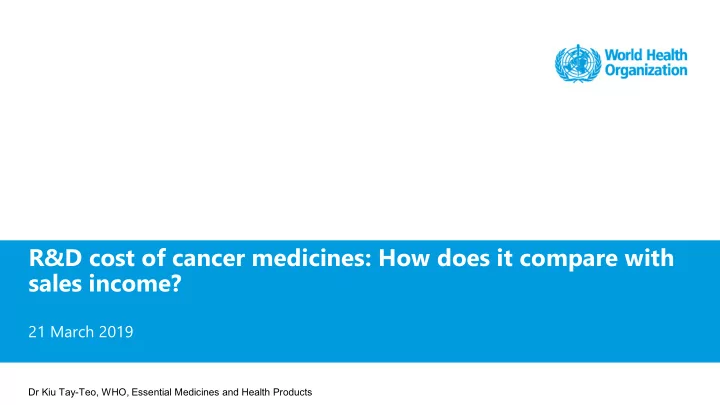

R&D cost of cancer medicines: How does it compare with sales income? 21 March 2019 Dr Kiu Tay-Teo, WHO, Essential Medicines and Health Products
Disclaimer in the article The conclusions in the article are the authors’ as individuals and do not represent the World Health Organization Policy
About the study
Resolution WHA70.12 requested a technical report On pricing approaches and their impact on availability and affordability of cancer medicines … the relationship between inputs throughout the value chain and price setting 4
Rationale and study objective High costs and high risks of R&D have been presented to justify high medicine prices Stakeholders have noted “generous” profit for some medicines e.g. imatinib, enzalutamide • Assessments were not comprehensive - only showing “successful drugs are successful” • Estimated R&D costs are highly variable: $100-150m to $4-6bn Needs to cover for the risks of failure • Needs to cover for the costs of capital • Different (and non-transparent) methodologies • Study objective To systematically compare sales incomes of cancer drugs approved by FDA with the R&D costs 5
Method (1) Design Observational study : Reported sales income of individual cancer medicines compared to the estimated overall R&D costs reported in the literature Scope : Medicines approved by FDA (1989-2017) for any cancer-related indications Sales income to the end of 2017 : Net of rebates and discounts but not expenses & taxes Data Sources : sales data from originator companies’ consolidated financial reports; risk -adjusted R&D cost from Prasad and Mailankody (2017) Missing data : growth rates, other sources, or estimated from known reported values if required Exclusion : Medicines with missing data for than half or more of the years since approval 6
Method (2) Analysis Standardization : All data expressed in 2017 US dollars with adjustments for inflation Descriptive statistics : Average and cumulative sales incomes, and return-on-investment (ROI) Uncertainty & assumptions Non-cancer indications : No adjustment for data if not disaggregated Three sensitivity analyses Indication extension : Incorporated costs of up to 5 post-approval Phase I-III trials • Excluded medicines : Incorporated R&D costs with accrual of $0 revenue • Higher than average R&D costs : 2 x base-case R&D cost estimates ($1.6b ; $438m-$5.6b) • 7
Findings
Sales incomes greatly exceeded R&D costs Sales income by 2017 Average income/yr since approval: $3m to $5.9b % ‘blockbuster’ drugs: 33.3% $2.8b Nr with total income $50 bn: 5 $794m Revenue ROI $219m Base case: $14.50 ($3.30-$55.10) Time to cover max R&D costs (2.8b) 5 years (2-10 yrs) R&D costs x2: $6.70 ($1.20-$27.10) Costs but no accrual of revenue for excluded meds: $8.80 ($1.70-$34.40) n= 99, N=156 9
Discussion
High prices of medicines are impacting all countries alike Access to cancer medicines globally remain low Low availability Countries with lower national income had lower availability of cancer medicines • Low availability of essential medicine list cancer medicines in LMIC and LIC • High out-of-pocket payments When available, prices are higher than deemed affordable • Impairing the sustainability of health systems Growing number of unaffordable medicines with annual costs at least in the tens of thousands Expenditure impact: exclude patients from coverage, restrict access, impose high out of pocket 11
Can ‘value’ justify the prices & returns of cancer drugs? Treatment with some cancer medicines clearly leads to substantial improvements in health outcomes Imatinib, trastuzumab, rituximab Inadequate evidence base Only one-third of FDA approved cancer medicines (2008-2012) showed prolonged overall survival Modest survival gains for drugs that improved survival Progression-free survival = 2.5 months Overall survival gains = 2.1 months Many drugs have safety concerns Risk of ‘toxic death’ and treatment discontinuation were greater for newer targeted drugs “No value in a medicine that is too expensive and sits on the shelf.” 12
Supernormal returns may distort investment Seemingly higher risks But significantly Oncology higher level of Lower probability of success 12.1% (non- oncology) vs 6.7% (oncology) investment Higher costs: e.g. for pivotal trials US$ 45.4m (oncology) vs US$8.8-29.4m (non-onco ex CVD) Inefficiency and “me - too mentality” “ Trial redundancy [in oncology] is “ Enormous redundancy in these blatantly evident ….… quite often studies [on checkpoint immune- these trials do not arrive at the same therapeutics], as many pharmaceutical conclusion or fail to provide a companies perform similar trials with definitive, practice-changing comparable drugs” (Workman 2017) outcome ” (Hutchinson 2015) 13
Conclusions
Returns are far in excess of possible R&D costs Cancer drugs, through their high prices, have generated substantial financial returns for the originator companies Existing approaches to managing the prices of cancer medicines have not resulted in outcomes that meet health and economic objectives Lowering drug prices through competition and regulations 15
Recommend
More recommend